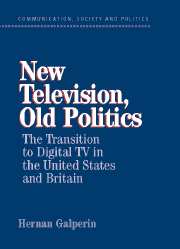Book contents
- Frontmatter
- Contents
- List of Figures and Tables
- Preface and Acknowledgments
- List of Acronyms and Abbreviations
- PART I A POLITICAL ECONOMY OF DIGITAL TV
- PART II THE AMERICAN ROAD TO DIGITAL TV
- 3 The Genesis of Broadcast Regulation in the United States
- 4 HDTV Comes to America
- 5 A New Bargain
- 6 A Long Journey
- PART III THE BRITISH ROAD TO DIGITAL TV
- PART IV NEW TELEVISION, OLD POLITICS
- References
- Index
6 - A Long Journey
from PART II - THE AMERICAN ROAD TO DIGITAL TV
Published online by Cambridge University Press: 24 July 2009
- Frontmatter
- Contents
- List of Figures and Tables
- Preface and Acknowledgments
- List of Acronyms and Abbreviations
- PART I A POLITICAL ECONOMY OF DIGITAL TV
- PART II THE AMERICAN ROAD TO DIGITAL TV
- 3 The Genesis of Broadcast Regulation in the United States
- 4 HDTV Comes to America
- 5 A New Bargain
- 6 A Long Journey
- PART III THE BRITISH ROAD TO DIGITAL TV
- PART IV NEW TELEVISION, OLD POLITICS
- References
- Index
Summary
By mid-1997 the American transition had entered its third phase. Neomercantilist considerations about the revitalization of the domestic electronics industry had long been abandoned. The building of an NII was still on the agenda, but in practice the government's task was limited to facilitating private investment and filling gaps in commercially unattractive areas. The country was riding a wave of unprecedented growth in the telecommunications and information technology sectors. As a result, the demand for spectrum grew exponentially. Some policymakers, notably FCC Chairman Kennard, challenged broadcasters to join the “Internet revolution” by offering digital TV services that would serve as a bridge for millions of Americans across the so-called digital divide. Yet, as the transition evolved, it became clear that incumbent broadcasters had other plans in mind. In fact, they had initiated the transition to keep spectrum out of the hands of land mobile operators and had successfully steered the process so that the migration created minimal disruption to the existing industry arrangements. The new bargain gave broadcasters flexibility to use the second channel for new services in return for an accelerated spectrum recovery schedule. In reality, few expected incumbent broadcasters to create such services. But at least the government could reclaim some valuable frequencies almost immediately, hand them over to more innovative companies for a price, and use those receipts to balance the federal budget. Spectrum recovery and fiscal receipts, not pretty pictures and new information services, constituted the political reality of digital TV.
- Type
- Chapter
- Information
- New Television, Old PoliticsThe Transition to Digital TV in the United States and Britain, pp. 109 - 126Publisher: Cambridge University PressPrint publication year: 2004

